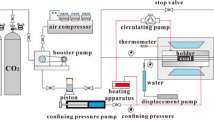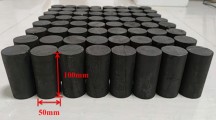Abstract
Flowability of gas and water through low-permeability coal plays crucial roles in coalbed methane (CBM) recovery from coal reservoirs. To better understand this phenomenon, experiments examining the displacement of water by gas under different displacement pressures were systematically carried out based on nuclear magnetic resonance (NMR) technology using low-permeability coal samples of medium-high coal rank from Yunnan and Guizhou, China. The results reveal that both the residual water content (Wr) and residual water saturation (Sr) of coal gradually decrease as the displacement pressure (P) decreases. When P is 0–2 MPa, the decline rates of Wr and Sr are fastest, beyond which they slow down gradually. Coal samples with higher permeability exhibit higher water flowability and larger decreases in Wr and Sr. Compared with medium-rank coal, high-rank coal shows weaker fluidity and a higher proportion of irreducible water. The relationship between P and the cumulative displaced water content (Wc) can be described by a Langmuir-like equation, Wc = WLP/(PL + P), showing an increase in Wc in coal with an increase in P. In the low-pressure stage from 0 to 2 MPa, Wc increases most rapidly, while in the high-pressure stage (P > 2 MPa), Wc tends to be stable. The minimum pore diameter (d′) at which water can be displaced under different displacement pressures was also calibrated. The d′ value decreases as P increases in a power relationship; i.e., d′ the coal gradually decreases with the gradual increase in P. Furthermore, the d′ values of most of the coal samples are close to 20 nm under a P of 10 MPa.
Similar content being viewed by others
References
Aguirre O, Glorioso J, Morales J, Mengual J (2007). Porosity with nuclear magnetic resonance in naturally fractured clastics reservoirs in the Devonian of the Bolivian Sub-Andean
Ahmed M, Gomaa Zhang B Y, Qu Q, Scott N, Chen J H (2014). Using NMR technology to study the flow of fracture fluids inside shale formations
Arnold J, Clauser C, Pechnig R, Anferova S, Anferov V, Blümich B (2006). Porosity and permeability from mobile NMR core-scanning. Petrophysics, 47: 306–314
Borgia G C, Bortolotti V, Fantazzini P (1999). Magnetic resonance relaxation-tomography to assess fractures induced in vugular carbonate cores. In: SPE Annual Technical Conference and Exhibition
Coates G R, Xiao L, Primmer M G (2000). NMR Logging Principles and Applications. Houston: Gulf Publishing Company
Fu G, Zhang Y, Zou D (1997). The measurement and analysis of the balanced contact angle between coal and pure water. Coal Convers, 20(4): 60–62 (in Chinese)
Jatukaran A, Zhong J, Abedini A, Sherbatian A, Zhao Y, Jin Z, Mostowfi F, Sinton D (2019). Natural gas vaporization in a nanoscale throat connected model of shale: multi-scale, multi-component and multiphase. Lab Chip, 19(2): 272–280
Kleinberg R L (1996). Utility of NMR T2 distributions, connection with capillary pressure, clay effect, and determination of the surface relaxivity parameter p2. Magn Reson Imaging, 14(7–8): 761–767
Levine J R (1996) Model study of the influence of matrix shrinkage on absolute permeability of coal bed reservoirs. In: Gayer R, Harris I, eds., Coalbed Methane and Coal Geology: Geological Society Special Publication, 109: 197–212
Li Y, Zhang C, Tang D, Gan Q, Niu X, Wang K, Shen R (2017). Coal pore size distributions controlled by the coalification process: an experimental study of coals from the Junggar, Ordos, and Qinshui Basins in China. Fuel, 206: 352–363
Li Y, Wang Z, Pan Z, Niu X, Yu Y, Meng S (2019). Pore structure and its fractal dimensions of transitional shale: a cross section from east margin of the Ordos Basin, China. Fuel, 241: 417–431
Li Y, Wang Y, Wang J, Pan Z (2020a). Variation in permeability during CO2-CH4 displacement in coal seams: part 1- experimental insights. Fuel, 263: 116666
Li Y, Yang J, Pan Z, Tong W (2020b). Nanoscale pore structure and mechanical property analysis of coal: an insight combining AFM and SEM images. Fuel, 260: 116352
Qin Y, Moore T A, Shen J, Yang Z, Shen Y, Wang G (2018). Resources and geology of coalbed methane in China: a review. Int Geol Rev, 60 (5–6): 777–812
Mitchell J, Gladden L F, Chandrasekera T C, Fordham E J (2014). Low-field permanent magnets for industrial process and quality control. Prog Nucl Magn Reson Spectrosc, 76: 1–60
Moore T A (2012). Coalbed methane: a review. Int J Coal Geol, 101:36–81
Shen J, Zhao J, Qin Y, Shen Y, Wang G (2018). Water imbibition and drainage of high rank coals in Qinshui Basin, China. Fuel, 211: 48–59
Strategy Research Center of Oil and Gas Resources Department of the Ministry of Land and Resources (2006). Assessment of Coalbed. Beijing: China Land Press (in Chinese)
Song Y Q, Ryu S, Sen P N (2000). Determining multiple length scales in rocks. Nature, 406(6792): 178–181
Sun X, Yao Y, Liu D, Zhou Y (2018). Investigations of CO2-water wettability of coal: NMR relaxation method. Int J Coal Geol, 188: 38–50
Talabi O, Blunt M J (2010). Pore-scale network simulation of NMR response in two phase flow. J Petrol Sci Eng, 72(1–2): 1–9
Tao S, Chen S, Pan Z (2019a). Current status, challenges, and policy suggestions for coalbed methane industry development in China: a review. Energy Sci Eng, 7(4): 1059–1075
Tao S, Chen S, Tang D, Zhao X, Xu H, Li S (2018). Material composition, pore structure and adsorption capacity of low-rank coals around the first coalification jump: a case of eastern Junggar Basin, China. Fuel, 211: 804–815
Tao S, Pan Z, Chen S, Tang S (2019b). Coal seam porosity and fracture heterogeneity of marcolithotypes in the Fanzhuang Block, southern Qinshui Basin, China. J Nat Gas Sci Eng, 66: 148–158
Tao S, Pan Z, Tang S, Chen S (2019c). Current status and geological conditions for the applicability of CBM drilling technologies in China: a review. Int J Coal Geol, 202: 95–108
Wu Y, Tahmasebi P, Lin C, Zahid M, Dong C, Golab A, Ren L (2019). A comprehensive study on geometric, topological and fractal characterizations of pore systems in low-permeability reservoirs based on SEM, MICP, NMR, and X-ray CT experiments. Mar Pet Geol, 103: 12–28
Yang J, Ma L, Liu H, Wei Y, Keomounlath B, Dai Q (2019). Thermodynamics and kinetics analysis of Ca-looping for CO2 capture: application of carbide slag. Fuel, 242: 1–11
Yang Z, Li Y, Qin Y, Sun H, Zhang P, Zhang Z, Wu C, Li C, Chen C (2019a). Development unit division and favorable area evaluation for joint mining coalbed methane. Pet Explor Dev, 46(3): 583–593
Yang Z, Qin Y, Wu C, Qin Z, Li G, Li C (2019b). Geochemical response of produced water in the CBM well group with multiple coal seams and its geological significance—a case study of Songhe well group in western Guizhou. Int J Coal Geol, 207: 39–51
Yang Z, Qin Y, Yi T, Tang J, Zhang Z, Wu C (2019c). Analysis of multi-coalbed CBM development methods in western Guizhou, China. Geosci J, 23(2): 315–325
Yang Z, Qin Y, Qin Z, Yi T, Li C, Zhang Z (2020). Characteristics of dissolved inorganic carbon in produced water from coalbed methane wells and its geological significance. Pet Explor Dev, 47(5): 1–9
Yang Z, Zhang Z, Qin Y, Wu C, Yi T, Li Y, Tang J, Chen J (2018). Optimization methods of production layer combination for coalbed methane development in multi-coal seams. Pet Explor Dev, 45(2): 312–320
Yao Y, Liu D (2012). Comparison of low-field NMR and mercury intrusion porosimetry in characterizing pore size distributions of coals. Fuel, 95(5): 152–158
Yao Y, Liu D, Che Y, Tang D, Tang S, Huang W (2010). Petrophysical characterization of coals by low-field nuclear magnetic resonance (NMR). Fuel, 89(7): 1371–1380
Yao Y, Liu D, Xie S (2014). Quantitative characterization of methane adsorption on coal using a low-field NMR relaxation method. Int J Coal Geol, 131: 32–40
Zhang Z, Qin Y, Yi T, You Z, Yang Z (2020). Pore structure characteristics of coal and their geological controlling factors in eastern Yunnan and western Guizhou, China. ACS Omega, 5(31): 19565–19578
Zhang Z, Qin Y, Yang Z, Jin J, Wu C (2019). Fluid energy characteristics and development potential of coalbed methane reservoirs with different synclines in Guizhou, China. J Nat Gas Sci Eng, 71: 102981
Zheng S, Yao Y, Liu D, Cai Y, Liu Y (2018). Characterizations of full-scale pore size distribution, porosity and permeability of coals: a novel methodology by nuclear magnetic resonance and fractal analysis theory. Int J Coal Geol, 196: 148–158
Zhong J, Abedini A, Xu L, Xu Y, Qi Z, Mostowfi F, Sinton D (2018). Nanomodel visualization of fluid injections in tight formations. Nanoscale, 10(46): 21994–22002
Zhu H, Xu X, An L, Guo C, Xiao J (2016). An experimental on occurrence and mobility of pore water in tight gas reservoirs. Acta Petrol Sin, 37(2): 230–236
Acknowledgements
Financial support for this work was provided by the National Natural Science Foundation of China (Grant No. 41772155), and the Advanced Basic Research Projects of China National Petroleum Corporation (2019B-4910).
Author information
Authors and Affiliations
Corresponding author
Rights and permissions
About this article
Cite this article
Yang, M., Yang, Z., Sun, B. et al. A study on the flowability of gas displacing water in low-permeability coal reservoir based on NMR technology. Front. Earth Sci. 14, 673–683 (2020). https://doi.org/10.1007/s11707-020-0837-x
Received:
Accepted:
Published:
Issue Date:
DOI: https://doi.org/10.1007/s11707-020-0837-x




